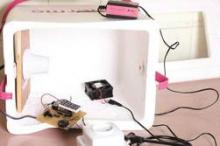A 3D printed speculum? Do-it-yourself urinalysis? Pushing back against traditional physician-patient roles, members of a European collective – GynePunks – are taking a radical self-help approach to women’s health, combining a feminist sensibility and a hacker’s DIY mentality.
The TransHack Feminist and Pechblenda groups, based in a “postcapitalist” collective just north of Barcelona, bring together radical feminists with engineers and other collaborators who have technical expertise. This loose affiliation works to construct and test tools meant to be used by women who are seeking self-knowledge and empowerment through self-care.
Klau Kinki, one of the founders of the GynePunks movement, explained that the strong social change thread running through the movement has its roots in what they see as some of the exploitative practices in the early history of gynecology. In an interview, Ms. Kinki said her research led her to “dig in the shame alleys of how medicine was built.”
One controversial example is the work of Dr. J. Marion Sims, an Alabama surgeon who pioneered vesicovaginal fistula repair by operating on slave women without anesthesia during the mid-1800s. Though ethicists continue to debate Dr. Sims’ actions in their historical context, Ms. Kinki is seeking to rename the Bartholin’s and Skene’s glands in honor of three of the slave women from Dr. Sims’ experiments whose names are known: Anarcha, Betsey, and Lucy.
The more Ms. Kinki read and learned, she said, the more she felt she needed to use the tools available to take matters into her own hands. Her experience as a Peruvian immigrant in Spain deepened her personal understanding of the impact that outsider status can have on health and well-being, she said.
Using assemblages of spare parts to fashion cell counters, fluid analyzers, and even microscopes, Ms. Kinki and her collaborators in the TransHack Feminist and Pechblenda collectives have put together prototypes that are part steampunk art and part low-tech working prototypes. She describes GynePunks as “a feminist tool developed inside [the] biohacking scene.”
Implications for health
Though the methods are unconventional and the vocabulary of radical “postcapitalist” feminism may be off-putting for
some, the GynePunks’ work could have serious and practical implications for women and those who care for their health.
Other low-tech, peer-to-peer approaches are already showing promise. For instance, researchers estimate that effective implementation of a low-tech cervical cancer screening program in India could save 22,000 lives annually. Health workers were recruited from the lay population and trained to perform a visual inspection of a woman’s cervix after application of acetic acid. These workers accurately identified those women with dysplastic lesions who needed referral for further care (J Natl Cancer Inst. 2014 Mar;106[3]:dju009).
The GynePunks hacking approach to women’s health, advocates say, also has the potential to help populations that may still experience isolation and barriers to care, even in wealthy, industrialized countries. These groups may include the uninsured and undocumented, LGBT individuals, and sex workers.
To that end, the GynePunks are collaborating with Gaudi Labs, a Lucerne, Switzerland–based group that explores open-source “biohacking” tools and techniques. Founder Urs Gaudenz has helped develop the open-source, downloadable software for a 3D printed speculum. Now, he, Ms. Kinki, and others in the movement are working on a full mobile lab, one that Ms. Kinki said “can be easily reproduced, and with at least the basic tools to perform some diagnoses.”
What it means in the United States
But the movement toward self-diagnosis and self-treatment worries some gynecologists. While acknowledging that barriers still exist for adequate care for many women, Dr. Constance J. Bohon, a gynecologist in Washington, D.C., is concerned that the movement “may do more harm than good.”
For many women’s health disorders, medical science offers the surest path to a cure, said Dr. Bohon. For example, though many herbal remedies exist for menopausal symptoms, “we know that these have been problematic,” and studies have not shown their efficacy when compared to best medical practice.
Real harm can be caused when some procedures are taken into the hands of laypersons, she said, citing the horrors of self-induced and lay abortions in the pre–Roe v. Wade era.
However, Dr. Scott A. Sullivan, an associate professor of ob.gyn. at the Medical University of South Carolina, Charleston, said he sees the innovations and the thrust behind the efforts of Ms. Kinki and her collaborators as both a natural extension of current trends in patient empowerment, and as a wake-up call for women’s health clinicians in the United States.




